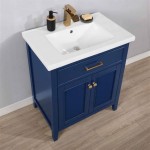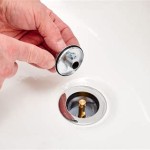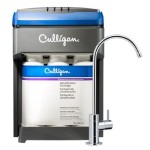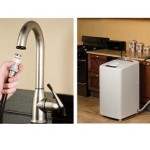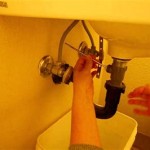Under Sink Water Filter Replacements: A Comprehensive Guide
Under sink water filters offer a convenient and effective solution for improving the quality of drinking water directly from the tap. These systems, installed discreetly beneath the sink, provide filtered water on demand, eliminating the need for pitchers or countertop units. A crucial aspect of maintaining an under sink water filter's performance is regular filter replacement. The effectiveness of the filtration process degrades over time as the filter media becomes saturated with contaminants. This article provides a comprehensive guide to understanding the importance of under sink water filter replacements, the different types of filters, factors influencing replacement frequency, and the steps involved in the replacement process.
Understanding the Importance of Regular Filter Replacement
The primary purpose of an under sink water filter is to remove various impurities from the water supply, ensuring cleaner, safer, and better-tasting drinking water. These impurities can include sediment, chlorine, lead, bacteria, viruses, and other contaminants, depending on the type of filter used. Over time, the filter media within the unit becomes clogged with these accumulated contaminants. This saturation reduces the filter's effectiveness, allowing contaminants to pass through into the filtered water. In some cases, a heavily saturated filter can even release trapped contaminants back into the water supply, negating the benefits of the filtration system.
Regular filter replacement is essential for maintaining the filter's ability to remove contaminants effectively. By replacing the filter at the recommended intervals, users can ensure that the water dispensed is consistently clean and free from harmful substances. Furthermore, neglecting filter replacement can lead to reduced water flow, making it more difficult to obtain filtered water. A clogged filter restricts water flow, impacting the overall convenience of the system. Maintaining consistent water quality and flow rate are both compelling reasons to adhere to a regular filter replacement schedule.
Beyond water quality and flow rate, there are potential health implications associated with neglecting filter replacements. Consuming water from a compromised filter can expose individuals to contaminants that the filter was originally designed to remove. These contaminants can pose health risks, particularly for vulnerable populations like children, pregnant women, and individuals with weakened immune systems. Therefore, regular filter replacement should be viewed as a critical aspect of maintaining a healthy household environment.
Types of Under Sink Water Filters and Their Lifespans
Under sink water filters utilize various filtration technologies to remove contaminants, each with its own lifespan and replacement schedule. Understanding the different types of filters and their expected lifespans is critical for planning and budgeting for filter replacements.
Sediment Filters: Sediment filters are designed to remove particulate matter, such as dirt, sand, and rust, from the water supply. These filters protect downstream filters from clogging and damage. Sediment filters typically have a lifespan of 3 to 6 months, depending on the sediment load in the water supply.
Carbon Filters: Carbon filters are widely used in under sink water filtration systems due to their ability to remove chlorine, volatile organic compounds (VOCs), and other taste and odor-causing substances. There are two main types of carbon filters: granular activated carbon (GAC) and carbon block filters. GAC filters generally last for 6 to 12 months, while carbon block filters, which offer finer filtration, typically last for 6 to 9 months. The lifespan also depends on the amount of chlorine and other contaminants in the water.
Reverse Osmosis (RO) Membranes: Reverse osmosis systems utilize a semi-permeable membrane to remove a wide range of contaminants, including dissolved solids, heavy metals, and microorganisms. RO membranes typically have a lifespan of 2 to 5 years, depending on the water quality and the system's pre-filtration setup. Sediment and carbon pre-filters are crucial for protecting the RO membrane from damage and extending its lifespan.
Specialty Filters: In addition to the standard filters mentioned above, some under sink water filtration systems incorporate specialty filters designed to target specific contaminants. These may include filters for removing lead, fluoride, or other substances of concern. The lifespan of specialty filters varies depending on the specific contaminant they are designed to remove and the concentration of that contaminant in the water supply. It is crucial to consult the manufacturer's instructions for the recommended replacement schedule for these filters.
Accurately tracking the type of filter installed and its replacement schedule is essential. Many systems have multiple stages of filtration, each with a different filter type and lifespan. Failure to replace each filter at the appropriate time can compromise the overall effectiveness of the system.
Factors Influencing Filter Replacement Frequency
While manufacturers provide general guidelines for filter replacement, the actual frequency can vary depending on several factors specific to the user's water supply and usage patterns. Understanding these factors can help users optimize their filter replacement schedule and ensure consistent water quality.
Water Quality: The quality of the incoming water supply is a primary determinant of filter lifespan. Water with high levels of sediment, chlorine, or other contaminants will require more frequent filter replacements. Users who live in areas with known water quality issues should consider testing their water regularly and adjusting their filter replacement schedule accordingly. Public water systems generally provide water quality reports, which can be a useful resource for understanding the contaminants present in the local water supply. Well water often requires more frequent testing and may necessitate more advanced filtration systems due to the potential for higher levels of contaminants.
Water Usage: The amount of water that flows through the filter also affects its lifespan. Households with higher water consumption will need to replace their filters more frequently than households with lower water consumption. The filter's capacity is measured in gallons, and exceeding this capacity will render the filter ineffective. Track water usage to determine the actual lifespan of your filter.
Filter Type and Capacity: As previously discussed, different types of filters have different lifespans. Furthermore, within each filter type, there are different capacities available. A filter with a higher capacity will generally last longer than a filter with a lower capacity, even under similar water quality and usage conditions. When selecting a filter, consider both the type of contaminants it removes and its capacity to ensure that it meets the household's needs.
Reduced Water Flow: A noticeable decrease in water flow is a clear indication that the filter is becoming clogged and needs to be replaced. While reduced water flow can also be caused by other factors, such as low water pressure in the plumbing system, it is often a reliable indicator of filter saturation. Ignoring reduced water flow can put additional strain on the filtration system and potentially damage its components.
Taste and Odor: The return of unpleasant tastes or odors to the filtered water is another sign that the filter may need to be replaced. Carbon filters, in particular, are responsible for removing chlorine and other taste and odor-causing substances. When these filters become saturated, they lose their ability to effectively remove these compounds, resulting in a decline in water quality. Note that certain naturally occurring minerals in the water may not be removed, even with a new filter.
Steps Involved in Under Sink Water Filter Replacement
Replacing an under sink water filter is a relatively straightforward process, but it is important to follow the manufacturer's instructions carefully to ensure proper installation and prevent leaks. Here is a general overview of the steps involved:
Gather Supplies: Before beginning the replacement process, gather all the necessary supplies. This typically includes the replacement filter(s), a bucket or container to catch any spilled water, a wrench (if needed), and a clean towel. Make sure the replacement filter is the correct type and size for the filtration system.
Turn Off the Water Supply: Locate the cold water supply valve under the sink and turn it off. This will prevent water from flowing into the filter system during the replacement process. It may also be necessary to turn off the water supply to the entire house if the under sink valve is not functioning correctly.
Relieve Pressure: Open the filtered water faucet to release any remaining pressure in the system. This will make it easier to remove the old filter and prevent water from spraying out when the filter housing is opened. Allow all the remaining water to drain from the faucet before proceeding.
Remove the Old Filter: Depending on the type of filter housing, it may be necessary to use a wrench to loosen it. Carefully unscrew the filter housing and remove the old filter cartridge. Be prepared for some water to spill out, and use the bucket or container to catch it. Dispose of the old filter cartridge properly according to local regulations.
Clean the Filter Housing: Before installing the new filter, clean the filter housing with a mild soap and water solution. Rinse the housing thoroughly to remove any soap residue. Inspect the O-ring or gasket that seals the filter housing to ensure that it is in good condition. If the O-ring is damaged or worn, replace it with a new one.
Install the New Filter: Insert the new filter cartridge into the filter housing, ensuring that it is properly seated. Screw the filter housing back onto the filter head, tightening it securely by hand or with a wrench, as needed. Do not overtighten the housing, as this can damage the threads.
Turn on the Water Supply: Slowly turn the cold water supply valve back on. Check for any leaks around the filter housing and connections. If leaks are present, tighten the connections or replace the O-ring if necessary.
Flush the Filter: Open the filtered water faucet and allow the water to run for several minutes. This will flush out any air or carbon fines that may be present in the new filter. The water may appear cloudy or discolored initially, but this should clear up after a few minutes. Follow the manufacturer's instructions for the recommended flushing time.
Check for Leaks Again: After flushing the filter, check for leaks again to ensure that the installation is secure. Monitor the filter housing and connections for any signs of leaks over the next few hours.
By following these steps carefully, users can successfully replace their under sink water filters and maintain the performance of their filtration systems. If you are uncomfortable performing the filter replacement yourself, consider hiring a qualified plumber or water treatment professional.

Ge Dual Flow Replacement Water Filters Advanced Filtration Fqk2j The Home

Ge Under Sink Replacement Filter Fqk1r The Home

Ge Universal Single Stage Replacement Water Filter Cartridge Fxuvc The Home

Simple Undersink Filter Double Pure Water S Llc

Ge Reverse Osmosis Under Sink Replacement Filter Fq18rt The Home

800 Gpd Tankless Ro System With Uv Sterilizing Light And Large Faucet Screen Waterdrop G3p800

4 Stage Under Sink Ro Replacement Filter Kit Isopure Water

Icepure Under Sink Water Filter System

The Best Under Sink Water Filter For 2025 Reviews By Wirecutter

Waterdrop Wd Rf15 Water Filter Replacement 15ua Under Sink Filtration System 16000 Gallons High Capacity

